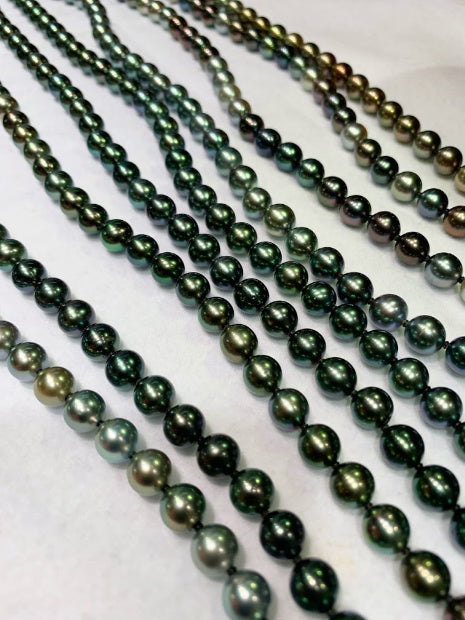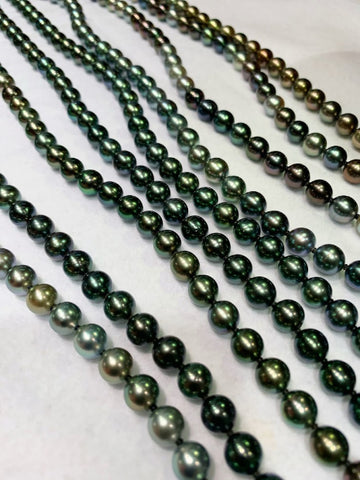Tiny 5 mm to 7 mm Tahitians—Did You Know They Exist?

Hong Kong. March 1, 2019. In 2015, CPAA member Alexander Collins, of the eponymous loose Tahitian pearl company based in the Takaroa atoll in French Polynesia, experienced a problem to which only Tahitian pearl farmers could relate: he ran out of mature oysters to graft. It’s a real (sad) phenomenon, because pearl farmers in Tahiti by and large do not have hatcheries—a consistent supply of oysters—to grow and use; Tahitian farmers primarily obtain oysters from the wild.

Tiny 7, 6, and 5 mm Tahitian pearls grown by Alexander Collins out of Tahiti.
Collins’ choice? Either stop grafting for three months (until age-appropriate or 9- to 10-centimeter oysters could be found) or do something that few Tahitian pearl farmers had ever done: graft smaller Tahitian pearls. This idea required not just smaller nuclei—from 1.6 bu (a reference to weight) to 2.1 bu versus the typical 2.2 bu to 2.5 bu—but also smaller knives and pincers (used to prop open oysters during nucleation), among other tools. His biggest priority? Keeping his staff, including two Chinese grafters skilled in seeding smaller akoya pearl nuclei, employed in the remote Tuamotu Archipelago.
Armed with those specialized staffers, Collins decided to give tiny pearls a try, seeding 20,000 oysters and leaving them in the water for 17 to 21 months. At harvest, he had 10,000 commercially viable pearls. The next hurdle? To pass X-ray control by the Tahitian government to ensure a standard minimum thickness of 0.8 mm. (This practice is no longer in effect.) Out of all the
pearls scanned, just seven were plucked from parcels for failure to adhere to the thickness regulation. The next stop for his tiny treasures? A jewelry trade show in Hong Kong.

Tiny 7, 6, and 5 mm Tahitian pearls grown by Alexander Collins out of Tahiti.
“Japanese buyers went nuts because they were used to small akoyas,” recollects Collins. A number of buyers low-balled on price and tried to buy him out, but he resisted so as not to devalue the specialness of the crop, which ranged in size from 5 mm to 7 mm a pearl. Typical Tahitian pearls grow in sizes ranging from 8 mm to more than 18 mm.
Now, a few years later, others have attempted to copy his efforts, but some don’t graft small enough beads, thereby creating thin nacre coatings. Plus, the colors belonging to others are oftentimes dull. Collins still offers some normal-size Tahitians, but he’s making tiny his signature. “We became a niche by necessity,” he explains from the current Hong Kong Trade Development Council International Diamond, Gem & Pearl Show taking place from Feb. 25 to March 2.
Thus far, his little pearls are a hit. One European client was seen sprinting to his booth to shop on opening day, and nearly all of his 6 mm numbers had sold by the show’s close. Pairs, hanks, and finished strands are available from $120 triple keystone to $450 to $5,400.
Collins’ price structure has evolved to mimic that of the high-end tiny Japanese akoya pearls—the smaller (and thus rarer) they are, the higher the price.
“Just as some companies have a monopoly on small sizes of akoyas, I want to be known for that in Tahitians,” adds Collins.
Reach Collins at adcdcs@yahoo.com.

This is proprietary CPAA content and may not be duplicated.


Comments on this post (14)
Wow . This pearls are so beautiful. Great for Mr. Collins. His effort and patience paid. Thank you for this article.
Thank you to Jeremy Shepherd for posting it in the forum.
— Ana Avancini
Oh wow! These are gorgeous! Kudos to Collins for taking this risk!
— Michelle Buettner
Where do we buy? These sound fabulous!
— Audrey
Wow where can I find Collins to be able to purchase these pearls . I really think it is going to be great having smaller Tahitian pearls as they can be used for so much more jewellery items . Well done Collins .
— Suzanne rollason
What a wonderful idea! There is, depending on location, more demand for small pearls than big ones; and Tahitian pearls are attractive by theyr color, but seem a bit bulky for some people. Tiny Tahitian pearls should be a success, I predict…
— Guillaume Coziol-Lespérance
Necessity is the mother of Invention. I am glad Alexander Collins has managed to produce Tahitians with good nacre and used smaller nuclei and instruments. He was lucky to already have exceptional Chinese grafters., glad their efforts have been rewarded. Well done for waiting for sales to keep the specialty of his pearls like those of the akoyas.
— Vivienne J Sadler
Awesome story!
— Katherine LaRose
Enjoyed article on the new tiny pearls.
— Shirley Lichte
I think that the Pearls are beautiful! I would prefer the smaller pearls. Thank you @Alexafer Collins for taking a risk and going outside the box!! The Tahitian pearl necklaces are breathtaking! 😊
— Debe Stanley
Thank you for this article . I have been searching for 5mm Tahitian pearls for a very long time. Can you please send me contact info on suppliers that would have them.
Thank you, Susanne Klevorick— Susanne Klevorick
yay for smaller tahitian pearls.
wait. now i have to revamp my thinking; and wrap my head around the implications of this. tahitians have such glorious luster and colour. now to expect it in smaller sizes?… i am excited, but also wary. (how long before unscrupulous companies attempt to capitalize on this little beauty?)
— courtney
Certainly bigger is not always better. These smaller pearls simply expand the design opportunities fo those of us who use Tahitian pearls. Great stuff. I need some!
— John Heldridge
Sooooo, when do we get to try them out.?.??
— Paul Coleman
That was a very exciting read and knowledge i love pearls and dont own black would love to own a pair ty for this article
— Rhonda valjean